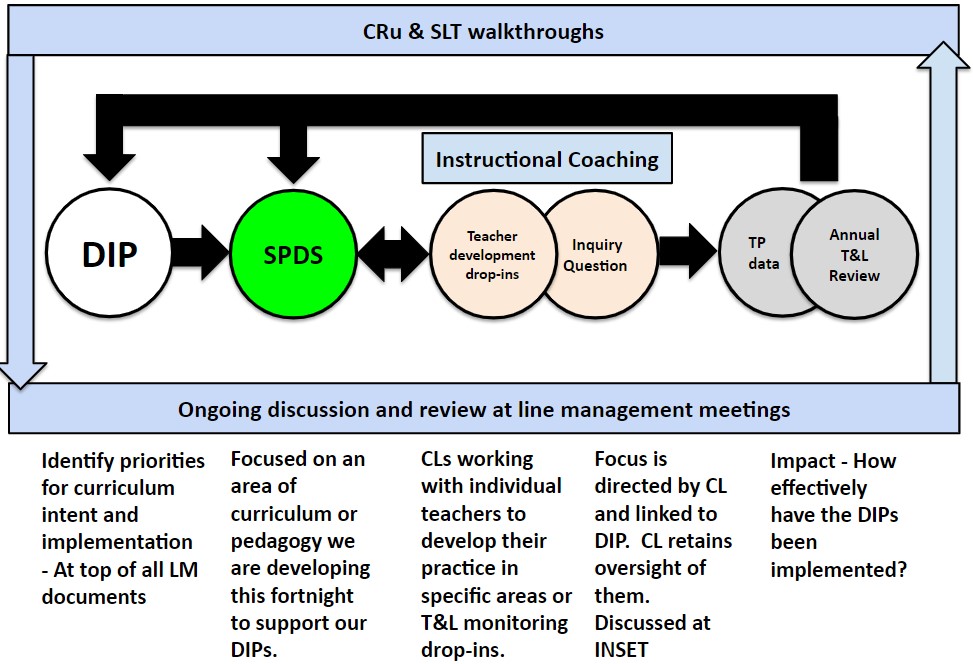Leading teaching and learning in a large secondary school is a great job. One of its many complexities, however, is that subject pedagogy is not universal, in fact, it is extremely different. That means the people you are leading, in the shape of subject leaders (or curriculum leaders as we call them), have greater expertise in their subject’s pedagogy than you do.
Why have someone like me leading teaching and learning then? Why not just allow curriculum leaders full autonomy and leave them to it? Well, that’s certainly an option, and not to do myself and my team out of a job, but in part I could see the attraction.
(Its also worth saying that the “me” in this blog is very much a royal “me” in that I have a small team that supports me in leading T&L here. That is one of the many benefits of being a research school.)
But, as I said, it is a great job and in my opinion does have value. If I’m doing it well, my role should be useful to curriculum leaders (and teachers) in a number of ways. Some (not exhaustive) would be:
- Support in interpreting evidence-informed approaches to teaching and learning in a subject specific way.
- Creating and maintaining a “tight but loose” framework for effective teaching that is meaningful for all and creates a common language across the school to talk about teaching.
- Creating and sustaining structures for effective subject specific professional development.
- Supporting the embedding of student routines that allow subject pedagogy to flourish.
A macro example of this would be designing a professional development structure that is consistent over a number a years that allows subject leaders to lead activity that helps their teams get better at specific teaching practices in their subjects. The micro would be helping a curriculum leader interpret metacognition in a way that supports the teaching of a specific chunk of their year 9 curriculum.
One aspect I’ve been really working at over the past couple of years is how I can give our curriculum leaders, and by proxy their teams, useful, meaningful and crucially formative feedback on the priorities they are working on.
There is more than one way to do that, and rather than document all of those I use, I just want to focus on one, what we call our T&L reviews. If I started again, I’d probably change the name as I don’t think it really describes what they are. However, I’m kind of stuck with them for at least this year because of all the laminated versions of the structure below up on office walls.

Essentially, T&L reviews are an opportunity for subject teams to get some feedback on where they are with their current priorities. As you can see, everything in our structure stems from the DIPs (department improvement plans). These are very pared down from the huge documents they used to be and are concise articulations of what teams are working on that term in four key areas: curriculum, teaching, assessment and routines & relationships. Our curriculum leaders together with their line managers write brilliant DIPs. I’m really proud of them. I say it all the time but at the start of each term when I read them all I’m blown away by the expertise they contain and how skillfully our curriculum leaders contextualise evidence-informed practice into something so subject specific, relevant and actionable. For example here is the “teaching” section of the current English DIP:
As you can see, they are not long. We aim for just a few bullet points per section. They are also a movable feast. The third bullet point is clearly a work-in-progress. In fact, in this case I know that these strategies have now been identified and are being worked on. The point is, the DIP is not for show, it is a genuine articulation of what leaders want to work on with their teams.
Therefore, the basic premise of the T&L reviews is that they provide useful feedback tied very closely to the DIP. They are not me and my team coming into the department and then deciding what their priorities are for them. This would completely undermine the DIP. They are also not about judging teacher effectiveness or department effectiveness, no summative judgement of any sort is made.
What they are designed to give is formative feedback against DIP priorities. Basically: “You want to develop in this area. We saw these aspects of that going really well (here are some examples), we think that you might have further still to go in these areas (here are some examples).“
We spend time before hand talking to the team and the leaders about the DIP and how aspects are going. We then spend lots of time in lessons having jointly decided on the best day to visit (we stress the importance of business as usual and given how many lessons I’m in across our school I can say we get it). We talk to the children, we look in books and we provide written feedback connected to each of the DIP’s bullet points. We then have a feedback meeting to discuss it all. If any teachers want more detailed individual feedback on lessons then we do that too. This is a collaborative process from start to finish and is about something that is a joint effort rather than something that is being “done to” the department.
So far, the feedback on them from curriculum leaders has been very good. Of course, the ideal would be to solely have specialists doing this for each subject. That’s not possible so we have to accept there is a limit to the feedback we can give. However, all curriculum leaders have said they have been able to use the feedback to help shape the professional development that has followed.
What’s been particularly heartening for me is to see how the reviews have influenced the DIPs that have followed and the teaching practice that I see in classrooms.
I’m not suggesting T&L reviews are the panacea for feedback at a department level, and try as I might I have been unable to completely remove the anxiety they create for staff being observed. However, I do think they have been valuable in reinforcing the importance of the DIP and as such supporting on-going subject specific professional development for Durrington teachers.
By Chris Runeckles









